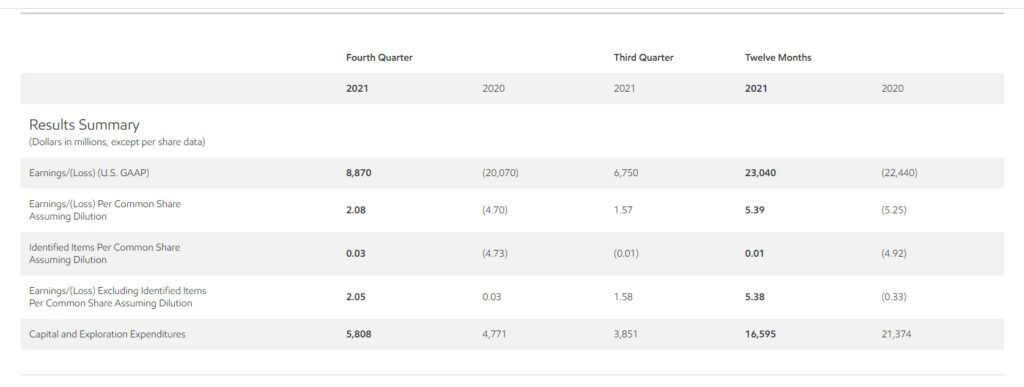
(Exxon, 1.Feb.2022) — Exxon Mobil Corporation announced fourth-quarter 2021 earnings of $8.9bn, or $2.08 per share assuming dilution, resulting in full-year earnings of $23bn, or $5.39 per share assuming dilution. Capital and exploration expenditures were $5.8bn in the fourth quarter and $16.6bn for the full year 2021, in line with guidance.
Highlights:
- ExxonMobil earns $23bn in 2021, initiates $10bn share repurchase program
- Generates $48bn of cash flow from operating activities, the highest level since 2012, more than covering capital investments, debt reduction, and dividend
- Reduces structural costs by an additional $1.9bn, increasing total savings to nearly $5bn versus 2019
- Strengthens balance sheet to pre-pandemic levels by paying down $20bn in debt
- Expects to achieve 2025 emission-reduction plans four years ahead of schedule
- Aims to achieve net zero Scope 1 and 2 greenhouse gas emissions for operated assets by 2050, with plans to achieve net zero in the Permian Basin by 2030
“Our effective pandemic response, focused investments during the down-cycle, and structural cost savings positioned us to realize the full benefits of the market recovery in 2021,” said Darren Woods, chairman and chief executive officer. “Our new streamlined business structure is another example of the actions we are taking to further strengthen our competitive advantages and grow shareholder value. We’ve made great progress in 2021 and our forward plans position us to lead in cash flow and earnings growth, operating performance, and the energy transition.”

Fourth-Quarter and Full-Year Business Highlights
Upstream
- Average realizations for crude oil increased 8% from the third quarter. Natural gas realizations increased 63% from the prior quarter.
- Oil-equivalent production in the fourth quarter was 3.8 million barrels per day. Excluding entitlement effects, divestments, and government mandates, oil-equivalent production increased 2% versus the prior-year quarter, and was also up 2% versus the prior year, driven by demand recovery.
- In 2021, production volumes in the Permian increased nearly 100,000 oil-equivalent barrels per day, with improved capital efficiency. The focus remains on continuing to grow free cash flow by increasing recovery through efficiency gains and technology applications.
- ExxonMobil continued to progress its low cost of supply deepwater developments in Guyana, with estimated recoverable resources increasing to approximately 10 bn oil-equivalent barrels, supported by six commercial discoveries in 2021. The Liza Unity floating production, storage, and offloading vessel arrived in Guyanese waters in October 2021.
- The sale of certain United Kingdom North Sea assets to Neo Energy was completed in December 2021.
Downstream
- Global refining margins improved from the third quarter with increased transportation demand driven by easing mobility restrictions, partly offset by higher energy prices in Europe. Fourth-quarter margins improved to the low end of the 10-year range, although jet demand remains challenged.
- Refining throughput in the quarter was the highest since 2013, up 2% from the third quarter, allowing the company to capture the benefit of improved industry margins.
- Lubricants earnings were a full-year record, as strong reliability performance enabled full capture of robust basestocks margins.
- The company acquired a 49.9% stake in BioJet AS, a Norwegian biofuels company that plans to convert forestry and wood-based construction waste into lower-emissions advanced biofuels, providing ExxonMobil the opportunity to purchase as much as 3 million barrels of lower-emission biofuel products per year.
Chemical
- Fourth-quarter industry margins declined from historically high levels to the middle of the 10-year range due to increased industry supply and higher feed and energy costs.
- Annual earnings of $7.8bn were a full-year record, reflecting robust industry demand, strong reliability, structural cost reductions, and the company’s global supply and logistics advantages.
- High-value, performance products grew 7% and the organization advanced key projects supporting future growth. The Corpus Christi Chemical Complex started up ahead of schedule and under budget, and a final investment decision was reached to proceed with a chemical complex in the Dayawan Petrochemical Industrial Park in Huizhou, Guangdong Province in China.
- ExxonMobil announced the acquisition of Materia, Inc., a technology company that pioneered the development of a Nobel prize-winning technology for manufacturing high-performance structural polymers. The innovative materials can be used in a number of applications, including wind turbine blades, electric vehicle parts, sustainable construction, and anticorrosive coatings.
- The company made its first commercial sale of certified circular polymer from recycled plastic, manufactured in Baytown, Texas, using proprietary advanced recycling technology. The advanced recycling operation in Baytown will be among the largest in North America with initial planned capacity to recycle 30,000 metric tons of plastic waste per year.
- ExxonMobil completed the sale of its global Santoprene™ business to Celanese in December for a total price of $1.15bn.
Leading the Drive to Net Zero
- The company expects to meet its 2025 emission-reduction plans four years ahead of schedule. This includes a 15-20% reduction in greenhouse gas intensity of upstream operations; a 40-50% reduction in methane intensity; and a 35-45% reduction in flaring intensity across the corporation versus 2016.
- In the fourth quarter, the company announced new emission-reduction plans through 2030, which include plans to achieve Scope 1 and 2 net zero greenhouse gas emissions by 2030 in the Permian Basin, and are consistent with Paris-aligned pathways, the U.S. and European Union’s Global Methane Pledge, and the U.S. Methane Emissions Reduction Action Plan. The company plans to invest $15bn in lower-emission solutions to both reduce its Scope 1 and 2 greenhouse gas emissions and support customers in decarbonizing, with a focus on carbon capture and storage, hydrogen and biofuels.
- In January, ExxonMobil announced its ambition to achieve net zero emissions from operated assets by 2050, backed by a comprehensive approach to develop detailed emission-reduction roadmaps for major operated assets. This ambition applies to Scope 1 and 2 greenhouse gas emissions and builds on the company’s 2030 emission-reduction plans. The Company’s roadmap approach identifies greenhouse gas emission-reduction opportunities for individual operated assets and the investment and future policy needs required to achieve net zero.
- ExxonMobil and Scepter, Inc. agreed to work together to deploy advanced satellite technology and proprietary data processing platforms to detect methane emissions at a global scale. Initially focused on Permian Basin operations, the agreement has the potential to redefine methane detection and mitigation efforts and could contribute to broader satellite-based emission-reduction efforts across a dozen global industries, including energy, agriculture, manufacturing and transportation.
- Since establishing the Low Carbon Solutions business in early 2021, ExxonMobil announced progress on 10 carbon capture and storage opportunities. The initiatives are in Houston, Texas; LaBarge, Wyoming; Edmonton, Canada; St. Fergus, U.K.; Southampton, U.K.; Fife, U.K.; Normandy, France; Malaysia; Indonesia; and Russia. These are in addition to previously announced projects in Qatar; Antwerp, Belgium; Rotterdam, Netherlands; and Australia.
Capital Allocation and Structural Cost Improvement
- In the fourth quarter, the company paid down debt by an additional $9bn, bringing the full-year reduction to $20bn, strengthening the balance sheet and returning debt to pre-pandemic levels.
- The company captured an additional $1.9bn in structural savings in 2021, increasing total savings to roughly $5bn relative to 2019. The company is on pace to exceed total annual structural cost reductions of $6bn by 2023. Building on this work, the company recently announced additional efforts to streamline its business structure to enhance effectiveness, grow value, and reduce costs. These changes will more fully leverage global functional capabilities, improve line of site to markets, and enhance resource allocation to the highest corporate priorities.
- During the fourth quarter, ExxonMobil’s board of directors approved the company’s corporate plan for 2022, with capital spending anticipated to be in the range of $21bn to $24bn.
- Beginning in the first quarter of 2022, the company initiated share repurchases associated with the previously announced buyback program of up to $10bn over the next 12 to 24 months.
____________________

